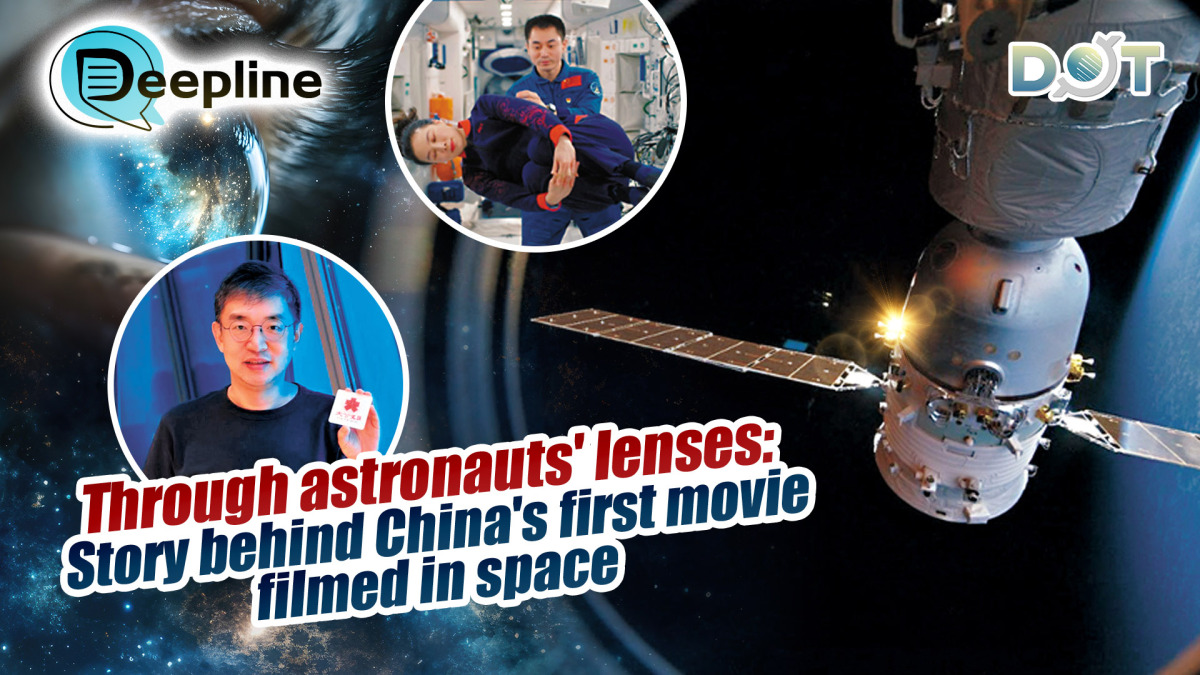
China's first space-shot film Shen Zhou 13 will land on the big screen in Hong Kong on October 1. At that time, the audience will be immersed in a unique "space narrative." The film's main subjects and space photographers are none other than the Shenzhou-13 astronauts Zhai Zhigang, Wang Yaping, and Ye Guangfu. During their six-month stay on the space station, they used cameras to capture precious snippets of their daily lives and scientific work, allowing the audience to get a close-up view of the life of Chinese astronauts in space.
Recently, the film's director Zhu Yiran accepted an exclusive interview with a Wen Wei Po reporter, sharing the behind-the-scenes story of this "seemingly crazy creative concept" from its inception to realization.
Looking up at the starry sky was a lingering space dream in the hearts of countless young people, and Zhu was no exception. In primary school, when he read the phrase, "Earth is the home of humanity, but humans cannot stay in the cradle of Earth forever," a seed of "wanting to be an astronaut" quietly sprouted in his heart. Although he didn't ultimately become an astronaut as he had wished, he connected with "space" in another capacity—becoming a documentary director, using the camera to record the era and dreams.
Around 2017, a chance filming opportunity allowed Zhu to see the modules of the Chinese space station with his own eyes for the first time. When he was inside, the awe-inspiring beauty of industrial design overwhelmed him, and a sense of power and happiness born from the crystallization of human wisdom instantly enveloped him. It was at that moment a bold idea sprouted in his mind: to point the camera towards space and make a space film for China. But he was also aware that the timing for filming was not yet ripe, and this dream had to be temporarily shelved.
Custom 8K 50fps full-frame space cameras
In the following years, news kept coming about global crossovers between aerospace and film: Tom Cruise planned to collaborate with the International Space Station on a movie, Russia was preparing the space-themed film The Challenge, and footage from the French space documentary 16 Sunrises even appeared in the 8-minute promotion clip for the Paris Olympics. Meanwhile, news about China's Shenzhou-13 mission and crew was also released. Zhu sensed that space was gradually becoming a new arena for the global film industry.
"In 2021, China was preparing to launch the core module of its space station, which meant we finally had our own long-term resident space station. The Shenzhou-13 crew could achieve stable residence and operation, providing the crucial hardware support for conducting film shooting on the space station," Zhu said. He immediately threw himself into the highly challenging task of writing a feasibility report and successfully obtained filming permission.
When the news came, Zhu was only excited for a short while before quickly diving into the extreme preparations required before "going to space." The first issue was the filming equipment. He contacted multiple equipment manufacturers to custom-make four fully domestically-produced 8K 50fps full-frame space cameras for the film.
Why was he so insistent on 8K high-definition shooting? Zhu replied, "The footage shot by astronaut Yang Liwei aboard Shenzhou-5 back then appears very blurry when viewed now. I hoped to use the most advanced imaging technology available today to clearly record this space station journey."
High definition was the core requirement, but to adapt to the limited space on the space station, the filming equipment had to be miniaturized. Simultaneously, charging issues in the space environment and data storage problems urgently needed solving. Every small detail posed a brand new challenge to China's film industry technology, and Zhu and his team drove technological breakthroughs by overcoming these difficulties one by one.
At the same time, the film's content creation was also progressing. Zhu constantly asked himself: What kind of space film did he want to make? Compared to previous documentaries focusing on mega-projects and national stories, how could this work achieve a new form of expression? This was not only his personal quest but a common reflection for all creators facing a new subject.
Finally, he found his direction: "I wanted the audience to follow astronauts Zhai Zhigang, Wang Yaping, and Ye Guangfu on an immersive space journey." Different from "hero narratives," he focused more on the ordinary daily life of astronauts inside the space station.
As the astronauts' training tasks were intensive, Zhu had very limited opportunities to communicate with them: "Before the Shenzhou-13 crew embarked on their mission, I only managed to secure a little over three hours of meeting time to discuss the key points and requirements of the shoot." For this reason, he prepared a detailed PPT in advance, listing everything from equipment usage methods to filming content requirements. Training on equipment operation was relatively easy; the real difficulty lay in "unifying the concept of filming." He hoped to make the astronauts clearly understand how to use the limited 40 memory cards over their six-month stay to shoot enough content to support a 100-minute film.
New starting point for dreams
After the film's successful release, many viewers wondered if there was a script for this movie. Zhu answered: "The core of the shooting outline was just one sentence—the astronauts are taking us to fly in space." He even joked about himself: "I am probably the only director who couldn't be on set to 'manage' the principal creators."
During the post-production editing stage, Zhu followed a simple logic: "When people arrive in a new place, they care about how to live and how to work." For example, after entering the space station, how do astronauts solve the problem of water supply? How do they eat and sleep in space? After settling their basic living needs, how do they conduct scientific research? When do they find a moment of leisure to gaze at the planets outside the window, or look at the Earth after nightfall? Are those feelings of longing from space the same as the concerns of every wanderer on Earth?
Answers to these questions were found in the film's details. After being invited to watch the film, science fiction writer Liu Cixin gave high praise: "This work is a mutual convergence of science fiction and aerospace. For the question 'how to make readers believe in the possibility of humanity venturing into the starry sea,' it provides the most powerful answer—not relying on special effects, but using real space scenarios and astronauts' stories to turn space exploration from a distant imagination into a tangible reality."
As a film creator, Zhu also felt deeply emotional: "Tracing back 120 years, Chinese cinema began its journey with the documentary 'Dingjun Mountain.' 120 years later, our camera lens can already aim at Earth from space. Technological progress not only changes our lives but also opens up broader horizons for film creation." He believes this film might bring inspiration to more directors: "In the past, saying 'let Chinese actors go to space to make a movie' might have been considered a pipe dream; but after Shen Zhou 13, this idea is no longer out of reach. At the very least, the 'space narrative' in film art now has fertile ground for dreams."
What he looks forward to even more is that this film can become a "seed." When children gazing at the stars feel the thrill from space on the silver screen, perhaps a "space dream" seed of their own will be planted in their hearts. And one day, these seeds will take root and sprout, nurtured by technology and dreams.
(Source: Wen Wei Po; Journalist: Hu Ruozhang; English Editor: Darius)
Related News:
Deepline | Recommending list of anti-fascist films: What are they, and why?
Journalist's View | Demon Slayer: Tale of growth, grief, and human heart




















Comment